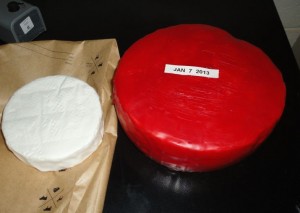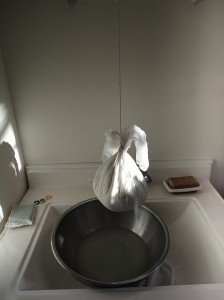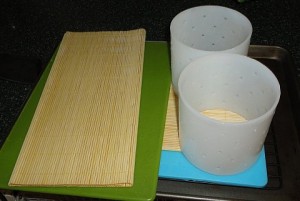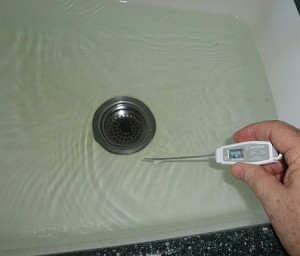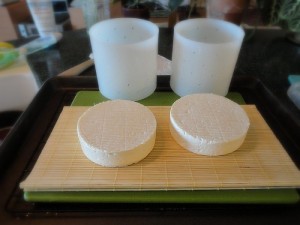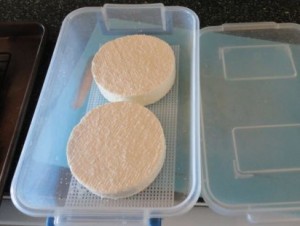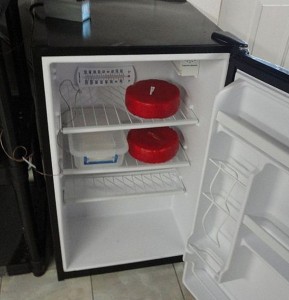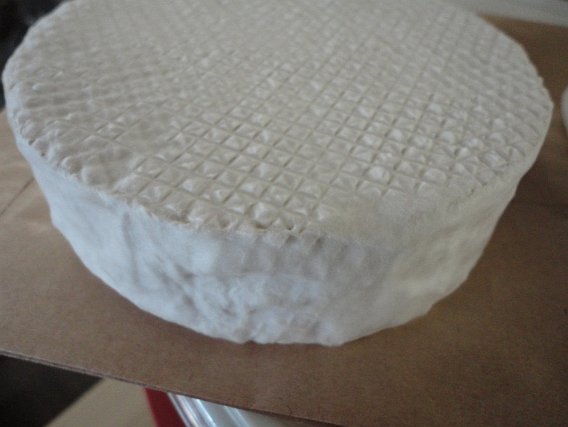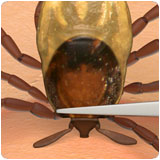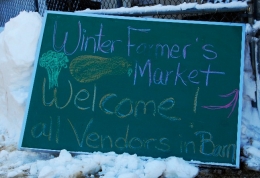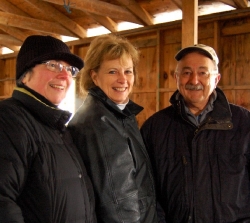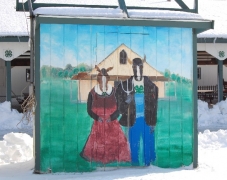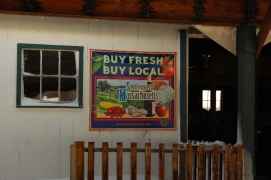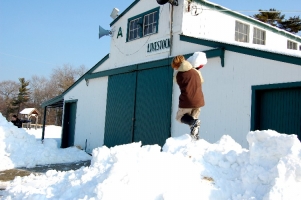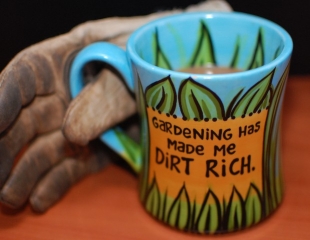Health
Making Cheese at Home
Blessed are the Cheesemakers
Life of Brian
Harry Poulter’s domain ranges beyond the garden and into the kitchen. He recently applied his skills at grain fermentation to another homemade specialty – Cheese making. Think of his story as “Rake and Palate…”
If you can cook, you can start making cheese at home. If you have ever brewed beer, you are halfway there. The simplest cheeses (fresh, spreadable) can be made in a day, with ingredients as common as milk and lemon juice. The most complex cheeses may require heavy presses and months or years of aging.
In addition to what you might think of as cheese, you can easily make cultured butter, yogurt, kefir, paneer, crème fraiche, mascarpone, cream cheese and many more cultured dairy products. I guarantee the fresh homemade varieties will delight you. Guests enjoy knowing you made the cheese you are serving. And savoring your own home-baked bread with your own homemade cheese or butter is an irreplaceable treat for the senses.
I got started when an old friend told me his precocious 11-year old stepdaughter was making cheese. That was a challenge I couldn’t ignore. I thought “Why am I not making my own cheese?” I had been making my own yogurt for years. A short time later, I had acquired the tools and knowledge and had the process down for making some basic and semi-advanced cheeses.
Interested? I’ll show you how to get started.
Cheese, Glorious Cheese
The origins of cheese making are lost in the mists of time, but the process was well established by the time of the ancient Romans and was described by writers of the period. Cheese making probably developed by a series of serendipitous discoveries, which led to a process by which the protein and fat of milk could be separated, solidified and preserved. Rennet and milk-digesting bacteria help acidify the cheese, and, with the addition of salt and other beneficial microbes and molds, inhibit the development of harmful or decay-producing microbes. The breakdown of proteins also leads to the development of wonderful flavors. Local milk varieties, native micro-flora and –fauna and special conditions (like caves) led to regional specialties. The ancient Romans especially esteemed cheeses from what is now France (for much more, see “On Food and Cooking – The Science and Lore of The Kitchen” by Harold McGee).
Information on Cheese Making
Get some good books on the subject. I find it is best, especially for the more complex cheeses, to compare several recipes and see what they have in common and how they differ. I keep a record (my “cheese log”) of each batch to record any notable successes or attempts that could be improved. The book I use most frequently is “Artisan Cheese Making at Home” by Mary Karlin. It’s a good reference and cookbook, though there are some math errors in some recipes (again, compare several sources). Second favorite is “200 Easy Homemade Cheese Recipes” by Debra Amrein-Boyes. I also use Ricki Carroll’s “Home Cheese Making”. There are also numerous online sources, YouTube videos, etc. The most useful online site is probably www.cheeseforum.org . Cheese making suppliers’ websites (see Supplies) also have recipes and tips.
Equipment and Supplies
If you are a cook, you probably have the equipment you need to make the simplest cheeses. For the more ambitious cheeses, you will need a few specialized items – molds for forming cheeses, a special ladle and curd knife, butter muslin (a fine-weave version of cheesecloth), draining containers, etc. My biggest investment so far has been a “cheese cave” which provides a controlled environment at about 50 degrees Fahrenheit. I use a “dorm-style” refrigerator, with no freezer compartment, that is plugged into a thermostatically switched outlet. The switch has a long wire probe that is run into the refrigerator to monitor the temperature. Amazon sells a good switch for about $50 (Johnson Controls A19AAT-2C). The best sources I have found for equipment, supplies and specialized ingredients are www.thecheesemaker.com and www.cheesemaking.com
Ingredients
First – the freshest dairy products you can find. A local dairy is your best choice. Try a farmer’s market, or Whole Foods. We have a smallish dairy in nearby Roanoke, VA that sells good quality milk and cream, including non-homogenized (cream on top) milk, which makes a superior cheese. For recipes requiring cream or half-and-half, look for brands which have no additives and are not ultra-pasteurized.
Mold cultures/bacteria cultures/rennets – These specialty ingredients require an initial investment, but they keep a long time. Store cultures in the freezer, rennet in the ‘fridge. Animal rennet is made from the stomach of calves, so some people avoid it. I find that vegetarian rennet is suitable for all but some long-aged cheeses. Commercial cheese manufacturers have started to use rennet produced by modified bacteria, but as far as I know this is not yet available to the home cheese maker.
Let’s make cheese!
1. Dead simple cheese (lemon cheese)
Ingredients
¼ – ½ cup fresh lemon juice (2 or three lemons)
½ tsp. salt – kosher salt works well
Optional herbs and/or garlic
Procedure
Heat the milk slowly, stirring frequently, to about 175 degrees F. Remove from heat and stir in ¼ cup lemon juice. Wait 15 minutes and see if you have a distinct separation of curds and clear whey. If the whey is still cloudy, stir in another tbsp. of lemon juice and wait another 15 minutes. Repeat until you have a clear separation.
Line a colander with several layers of cheesecloth (or use butter muslin if you have it). Dampen the cloth and dump the contents of the pot into it. Set the colander over a bowl if you want to save the whey (for bread making). You can either leave it to drain as is, or gather up the cloth into a bag and hang it. After an hour or two, it should have a good firm texture.
Put the curds in a bowl and stir in the salt. You can also add a mixture of herbs (Herbes de Provence is good), chives, garlic, etc. to taste. Refrigerate to firm up the cheese and blend the flavors. This cheese will keep well for about a week.
2. Camembert – A good beginner’s “real” cheese.
I won’t give every detail of the recipe here, since it is widely available, and you should have at least one good cookbook before you get this far, but I will illustrate the process.
Sanitation
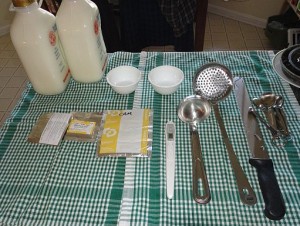
Thermometer, ladles, curd knife, measuring spoons, etc. All sterilized and laid out on a clean cloth. The foil packs hold the bacterial and mold cultures.
Since this cheese needs to age for a while, we need to be more careful about sanitation than with our quickie lemon cheese. We don’t want bad bugs or molds to get a foothold. The first step is to sterilize all cooking vessels and equipment that will contact the milk and cheese. A weak bleach solution (1 tsp/gallon of water) is sufficient. Brewer’s B-Brite or similar oxidizing cleaners will also work.
The perforated PVC sections are open-bottomed molds, or “hoops”, for forming the Camembert. The bamboo mats are sushi mats. Also a rimmed baking sheet and two plastic cutting boards. All have been sterilized.
Procedure
Heat the milk, slowly, in a heavy-bottomed (sterilized) pot to 85 degrees F. Then sprinkle on the starter culture (bacteria), and the cheese molds which will form the white rind of the Camembert. After letting the cultures hydrate on the surface for a few minutes, stir them in and hold the temperature for 90 minutes. Most cookbooks advise you to use some kind of double boiler or stove-top water bath to maintain heat. I just fill the kitchen sink with water at the target temperature.
After the curds have achieved a “clean break” from the whey, we slice the curds into chunks. They will not be neat cubes, but a cottage cheese-y mess. The whey should be clear, though.
After cutting, the curds are stirred, then allowed to rest to consolidate and further separate from the whey.
Once the curds are consolidated, we spoon them into the two hoops, which are set upon a sushi mat, which is on a cutting board inside the baking pan.
Then, another sushi mat and cutting board are placed on top. Periodically, we need to pick up the whole assembly and flip it so the alternate cutting board is on the bottom. This is a little tricky. We may also need to drain the bottom pan.
After repeated flipping and an overnight rest, the cheeses are consolidated into their final form. They have picked up a nice pattern from the sushi mats. At this point, they are rubbed with salt to inhibit “bad” mold formation and moved to a draining container.
My cheese “cave” is a refrigerator I modified to maintain 50 degrees. The red cheeses in the photo are Jarlsberg (I hope. I won’t know for a couple of months how they turned out).
The Camembert rounds stay in the draining container for about 2 weeks. After that, they are moved to cheese bags or plastic wrap, still in the “cave”, for about another 2 weeks, until the centers are soft. Then they can be moved to regular refrigeration and the aging process stops. You don’t want to over-age a Camembert, because it will start to break down and get a little stinky. Still safe and edible but not as tasty.
Finally…
Almost finished Camembert covered with fine white mold.
Happy cheese making!
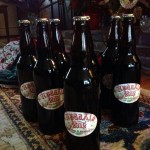
WaddAle 2012 – Marshfield Homebrew
This year, after a long hiatus, I was inspired to brew a batch of “WaddAle,” my nearly eponymous homebrew that I last concocted in 2006. The topic came up while we stood in Small Bar, a hole-in-the-wall beer joint in San Juan, Puerto Rico. Why not? Thus, the plan for WaddAle 2012 was born. Here’s how it worked.
Assemble ingredients
I needed a beer kit. I’m not an adventurous ale maker, I use a kit of pre-selected, pre-measured ingredients. Then, I typically introduce a personal variation. On an errand I accidentally discovered The Homebrew Emporium, a new to me beer supply outlet in Weymouth, MA, managed, it turns out, by an old thespian friend, Jim Bowser. I took that as a good omen.
Nut Brown Ale beer brewing kit from Beer Emporium
I selected their Nut Brown Ale kit (~$32). I’ve also used the True Brew brand kits from Pioppi’s Package store in Plymouth, MA. These beer making kits contain all the ingredients plus brewing instructions, but you need your own equipment – brew pot, fermentation tank, tubing, valves, bottles, caps, capper, etc. Fortunately, the Homebrew Emporium has all that stuff. I had my equipment on hand from my old True Brew Maestro kit.
Next to godliness
The beer gods require cleanliness – the magic of fermentation creates alcohol and fizz but the nutrient rich brewing medium (aka wort) can just as easily nourish invading microbes who will spoil your batch and doom your brew. I avoided that calamity by taking seriously the cleanliness principle. So, first step is always cleaning and sanitizing the equipment with a special cleansing solution (I used B-Brite). I also bought new glass bottles, instead of reusing old ones. For my style of occasional brewing, saving money comes second to simplifying the process. I’ve since learned of a product called PBW (Powdered Brewers Wash) that’s said to positively eliminate any organic residue – so thriftier folks should look into that.
Stinking up the house
If you relate well to the pervasive, hoppy/yeasty smell of a brewpub, you’ll like the next part — brewing the wort. In my case, I announced my brewing plans in advance and waited til I had the house to myself for half a day to spare the sensitive noses.
cooking the wort
Combining ingredients per the given instructions, you end up with a bubbling, gurgling, sometimes overflowing pot of deep brown liquid that cooks for about an hour. Toward the end of this process, I added 4 oz. organic chocolate and
slivered orange peel for seasonal effect, having sanitized the orange peel in advance.
The brewing step ends with transferring the hot wort to the fermenting tank, adding water to make 5 gallons and waiting for it to cool to the right temperature (~78° F.) to allow brewers yeast to kick in. Too hot destroys the yeast critters. I underestimated the cool down time — it took hours and hours (Note to self – start with really cold water in the fermentation tank next time).
Airlock releases carbon dioxide
Finally, I sprinkled and lightly stirred in the brewers yeast, snapped on the lid, fitted the airlock and lugged the tank into the back room. Next morning the fermentation bubbles were manically rattling the airlock. Yes!
Bottling the batch
Waiting for fermentation to complete took about 10 days. Bottling began with — you guessed it: sanitizing. Here’s where having brand new, long neck bottles helps. To further reduce the cleaning and bottling effort, I used 24 oz. bottles, instead of 12 oz. ones. I cleaned and sanitized the bottles, bottle filler, filling tank and tubing in the downstairs bathtub using B-Brite again. Dissolving the priming sugar in boiling water, adding it to the filling tank and siphoning the fermented wort into it readies the filling process. Then, I simply attached the tube to the spigot and let ‘er rip. Capping is fun and makes it feel like a real bottling operation.
Sharing the bounty
As Christmas week approached I retrieved bottled WaddAle from the basement fermentation zone, labeled each with my 2012 WaddAle label (Avery 22829), and packaged shipments for points west, north and south with instructions for awaiting complete bottle conditioning (another week or so). So, if you’re a WaddAle recipient — today’s the day! Open and salute the end of 2012 and the beginning the new year! If you feel left out, well… get busy and brew!
May Tidings

My new rain gauge near the clematis
How Dry I Am
Kate and Ryan gave me a rain gauge for my birthday. How neat. I like that it measures my rain in my yard – no more looking up our regional rainfall in the Boston Globe. I’m empowered!
Our friends, Grace and Jerry, went a step further and installed a sophisticated electronic weather monitoring system. It required them to scale heights to attach an anemometer onto their roof. I’m not there yet.
We have a winner
Also for my birthday I was gifted with a lottery ticket. It delivered me $100! I purchased with the proceeds a new white flowering dogwood (cornus florida) and heaved it into the earth close by our cherished, but aging, same variety dogwood that so beautifully graces the yard in April and May. Mild winters provide a bountiful spring bloom and there is nothing more special than that tree in our garden. Hence, adding a new generation before the old one passes.
Tick Smarts
I recently joined the Arnold Arboretum and attended a lecture there on Thursday, May 17 called “More Ticks in More Places” presented by Dr. Thomas Mather from the University of Rhode Island Tick Encounter Resource Center (tickencounter.org). Smart guy. Massachusetts and Rhode Island are the epicenter for deer tick-borne Lyme disease. It’s worth looking at his excellent website for all tick-related concerns.
Also, there’s a new tick approaching from our south called Lone Star tick – Long Island and New Jersey are already infested; it carries Rocky Mountain Spotted Fever. Fun.
As a result, I’m in the market for permethrin treated clothing and we just renewed Daphne’s “Evolution” treatment. He covered so much – dispelling myths, top ten things everyone should know, personal protection measures, safe removal, etc. Tip: after you come in from outdoor activity, throw clothes in the dryer first, then the wash. Ticks die in dry heat, but may survive washing.
A Man’s Home Is His Castle
Prepping for our golden years, we’ve begun a comprehensive house renewal program. New shingled roof, replaced worn and weathered trim boards/sills, created a portico (!) over the front door, four new windows, and new stoop and replaced cedar shingles on the back of the house. Son-in-law Ryan Flynn (yes, that Ryan Flynn) designed and crafted the portico. We’re delighted! We believe the painters will start next week. Maisy appraised our new white cedar shingles yesterday and declared: “Nice and clean!”
Midday Saturday on a beautiful May weekend. Chores. This evening we attend a performance by Coro Allegro of Rachmaninoff’s Liturgy of St. John Chrysostom at the Church of the Covenant in Back Bay.
Marshfield Farmers Market Public Secret
Like Poe’s Purloined Letter, Marshfield’s Winter Farmers Market is hiding in plain sight.
Building on the steadily growing popularity of farmers markets locally, regionally and nationally, the folks who bring you the annual Marshfield Fair (Marshfield Agricultural and Horticultural Society) converted a corner of the fairgrounds into a Farmers Market that runs throughout the summer and fall harvest seasons (June-October). The Fair itself, a highlight of Marshfield’s summer, was founded in 1867.
Growing and harvesting a tradition
2010 marked the 5th season of the Marshfield Farmers Market. The summer market is establishing a new tradition for locavores and community farmers.
Late in 2010, they took it another step — converting the fairgrounds’ 4-H Club shed into a frosty, enclosed market for winter shoppers. It began as a pre-holiday event in November, 2010.
“It’s an experiment,” says Market Manager Karen Biaginni (pictured here with her team of Janet Scribner and Bill Frugoli). The result? So far so good.Following their early success, they added dates for January and February 2011 – next one is Saturday, February 26. (South Shore citizens take note!)
Market Day, January 2011
We stopped by the market on Saturday, January 29, which turned out to be one of the few sunny days in an otherwise messy month. Inside the 4-H barn we made the rounds.
First stop was Rise and Shine – a community supported agriculture (CSA) farm in Marshfield, run by Marta and Doug MacFarland. We selected from a variety of fresh root vegetables (onions, acorn squash, cabbage, small potatoes, turnips, rutabaga and popping corn on the cob). You can order in advance from their website and join their mailing list, too. Fan Carolyn Housman (Marshfield, MA) stated “I am really turned off by grocery store waxed and soft turnips when I can buy it from Marta.” We bagged colorful dwarf onions and a few squash.
[Not a valid template]
Tending to local agriculture
Marshfield Farmer’s Market enjoys membership in the Southeast Massachusetts Agricultural Partnership (SEMAP), an organization formed in 1998 to promote regional stewardship of agricultural lands (and aquaculture). According to their website
SEMAP was a creation of necessity, as there was a void in our part of the commonwealth. SEMAP became the organization providing a comprehensive source to help the region’s farmers and aquaculture operators navigate the many agencies and organizations that provide support and resources to farming operations in the region. (Bristol, Plymouth and Barnstable Counties)
Bringing it home
I was seduced by cinnamon from Guiseppe’s Cakes (Hanover, MA) , and chatted with owner Joseph Perella. To qualify for a spot in the market your offerings must be locally produced (this ain’t no flea market, baby) and Joe is proud of his product. I chewed through a tasty cinnamon twist — sweet and fresh, although I was hoping for the hard-to-find flaky variety. “My specialty is my cakes,” he explained. And he had the goods to prove it.
I munched and meandered down the aisle to the outpost for Open Meadow Farm (Lunenburg, MA), producer and purveyor of pasture-raised organic meat. Robin and Charles Dance get help serving customers from daughter Rebecca. Open Meadow Farm often takes orders in advance of market day from a growing band of happy customers who won’t be disappointed. Finally I know the answer to “where’s the beef!” [Not a valid template]
Psssst — Marshfield has a market, Pass it on
While most of the action occurs in the summer market (lots of produce, live music, crafts, bigger crowds), the winter market brings out true believers. It’s a great new tradition for our neck of the woods. But don’t take my word for it — bundle up and check it out yourself. For more information tell ’em to put you on their mailing list — jgscribner @ hotmail.com
So, how do you satisfy your locavore? Add a comment and share your sustainable story!
Dirt – A Love Story
It’s everywhere! We scrub it off our hands, our shoes, our personae. We think: clean = good, dirt = bad. Even gardeners succumb to dirt-riddance — we clean our gardens in the spring! But I’m telling you — dirt is your friend, not your enemy.
Here’s why.Get Smart – Eat Dirt!
Dirt harbors essential micro-organisms (like bacteria and fungi). “Yikes!“, you shriek, “That’s a good thing?“. Not just good, essential.
Soil scientists say each gram of soil (less than a teaspoonful) contains over 1,000,000,000 microbes (1 billion!), hosting over 10,000 different species. Here’s what some of these buggers do:
- grow our crops,
- convert wastes into compost,
- deliver vitamins to plants (in the “rhizosphere“),
- kill insects,
- consume toxic waste (like oil spills), and
- create soil in the first place
When soil is first made, for example after a volcano, some nutrients are missing, including nitrogen and carbon. Therefore, the first organisms to colonize the soil are generally nitrogen fixers and photosynthesizers that fix carbon. [DLC-ME]
Furthermore, a study conducted by researchers Dorothy Matthews and Susan Jenks at The Sage Colleges (Troy, NY) suggests that soil-borne germs play a role in reducing anxiety and enhancing learning. The study attracted lots of coverage, like “Can Bacteria Make You Smarter?” (Science Daily) and on Radio Netherlands “The Dirt Show“. Here the two researchers pose with dirt martinis (yuk!).
Anyway, get smart — eat dirt!
Dirt – Accidentally in Love
I began my wholesome relationship with dirt by accident, often the case with true love. I had planned a border along the front driveway and set to work removing a strip of sod about 2 feet wide and 80 feet long. I had loam delivered to create the bed where the sod once was. For expediency, I dumped the torn up sod in a low spot in the backyard; it formed a chunky mound on which I later dumped fall leaves and some additional loam on top to hold it all in place.
I finished the driveway border project, planting daylilies, astilbe and daffodils topped with a layer of bark mulch. Over the next couple of years I expanded the experimental mound in the backyard, adding a curved path with pea stone gravel, throwing in Bleeding Hearts, Oriental lilies, astilbe, a leftover Alberta Spruce, a red twig dogwood, Japanese dwarf spirea, ferns (etc.). What I found was — it didn’t matter what I planted there. Everything flourished. I had accidentally created a rich, organic home for my woodland plants! Dirt won me over and I’m accidentally in love!
I’ve since enlarged the accidental garden with yard clippings, chopped oak leaves, more loam, and barn “soil” from a nearby stable. In the expanded section, I added shrub roses, Columbine, an ornamental Japanese maple, American ginger, epimedium, sweet pepperbush (Clethra) and a stone wall. We’re happy together.
The Joy of Dirt
Back to the driveway border. It perennially struggles — its loamy bed dries out in summer because it doesn’t have enough organic material to store water for long. The day lilies come up OK, but they haven’t prospered; ditto the daffodils. Some day, I will re-visit this project and give it the tender lovin’ dirt it needs.
I’ve started another mound in the front yard: lawn clippings, chopped leaves, compost from the Marshfield transfer station (aka, the dump), and a decorative covering of bark mulch. It’s January and the mound is slumbering beneath a foot of snow, while microorganisms and worms are busily feeding and creating new dirt. Oh, joy!
Now it’s your turn — Share the dirt!
Hyperfocusing, or My Aching Back
 Gardening "In the Zone". Hyperfocus is great for accomplishing tasks while displacing the cares of the world. I end up with pride of accomplishment and a self-induced worry-free reverie. But when the sun sets and I exit "the zone" I suddenly notice my aching back. Read the rest of this entry »
Gardening "In the Zone". Hyperfocus is great for accomplishing tasks while displacing the cares of the world. I end up with pride of accomplishment and a self-induced worry-free reverie. But when the sun sets and I exit "the zone" I suddenly notice my aching back. Read the rest of this entry »

